| "Our nation is enjoying an unprecedented time of peace and wealth. Our people are happy, and we're so fortunate in so many ways. [...] we should share this prosperity with the rest of the world. In our hands is the most successful empire in history. It's time we expanded it." |
| — Fire Lord Sozin to Avatar Roku about his plan that would lead to the start of the Hundred Year War.[1] |
The Hundred Year War, also known as the War or the Great War, was a major global military conflict that lasted for a century. The struggle was between the Fire Nation and the other three nations: the Earth Kingdom, the Water Tribes, and the Air Nomads. However, over the course of the escalating conflict, several smaller factions became involved in the fighting as well. The war was initiated by Fire Lord Sozin, who wished to expand the Fire Nation into a worldwide empire and spread what he saw as his nation's prosperity to the rest of the world.[1]
Taking advantage of the absence of the Avatar and using their economical, technological, and military superiority for most of the war, the Fire Nation was able to wreak worldwide destruction and widespread loss of life in the other nations. The war began in 0 AG with the infamous genocide of the Air Nomads, whose air temples were falsely presumed to be unassailable to the Fire Nation due to the Air Nomads possessing the sole means of getting to them.[4] Following the destruction of the Air Nomads, the Fire Nation launched a massive coordinated invasion on the western Earth Kingdom. For the next one hundred years, the Fire Nation slowly advanced into the Earth Kingdom and established several colonies on the mainland. The Fire Nation also initiated raids on the Northern and Southern Water Tribes, which devastated the South, while the North managed to remain relatively untouched for almost a century. By 99 AG, the Fire Nation had effectively eradicated the Air Nomads, virtually annihilated the Southern Water Tribe, and controlled almost the entirety of the Earth Kingdom, to the point of near victory. The last strongholds able to defend themselves were the Northern Water Tribe and the Earth Kingdom cities of Omashu and Ba Sing Se.
Upon the Avatar's return in 99 AG, the Fire Nation undertook a far more aggressive plan of attack, taking bigger risks to deliver devastating blows to their opposition and render any possible intervention from Avatar Aang too late. This strategy resulted in colossal setbacks for the Fire Nation when the Avatar became involved. Notably, the Fire Nation launched a massive invasion of the North Pole, after they realized that Aang was taking refuge there, and suffered a crushing defeat at the last second when the Ocean Spirit and Avatar merged to intervene. Similarly, an effort to breach the walls of Ba Sing Se utilizing a giant drill was also thwarted. Despite these setbacks, several victories were also won including the surrender of Omashu and the infiltration and Fall of Ba Sing Se, leaving the Northern Water Tribe as the last remaining stronghold to Fire Nation hegemony. In an effort to turn the tide of the War, an army assembled from the remnants of the Southern Water Tribe and members of the Foggy Swamp Tribe and Earth Kingdom attempted an invasion of the Fire Nation Capital on the Day of Black Sun in mid 100 AG, when firebenders were powerless and as such incapable of defending against a siege. The invasion ultimately failed, with nearly all members of the invasion force captured by the Fire Nation.
Nevertheless, the Hundred Year War ended roughly a year following the reappearance of the Avatar due to a combination of efforts of the remaining two nations, the Avatar's group's destruction of the air fleet meant to use Sozin's Comet to deliver the killing blow to the Earth Kingdom, Aang's victory over Phoenix King Ozai, and the newly crowned Fire Lord Zuko's intention to restore peace and harmony among the four nations.[5]
However, the Hundred Year War had changed the world forever; one whole nation and its unique bending art had been virtually wiped out, and it would only slightly recover in the following 70 years. The Fire Nation had become an ethnocentric and autocratic dictatorship, and much effort had to be applied to restore a tolerant attitude among its people as well as its image among the other nations, which had come to hate the country after a century of conflict that it initiated. On the contrary, great technological and industrial advancements had been conducted by both the Fire Nation and Earth Kingdom during the war. The different nations had also blended to create new and diverse cultures in the older Fire Nation colonies,[3] which eventually led to the foundation of the United Republic of Nations, a new sovereign state comprised of a multitude of citizens from all nations.[6]
Prelude
Rise of the Fire Nation
Following its unification,[17] the Fire Nation gradually became powerful and militaristic, placing great importance on cohesion, strength, and effectiveness.[18] It developed an extremely capable military, including the most powerful navy in the world,[19] and fought many wars against the other nations.[20] By the 1st century BG, an industrial revolution in the Fire Nation saw its economic, military, and living standards greatly outpace those of the other nations.[1][21] Unrest in the Earth Kingdom had greatly weakened its government,[16][22][23] and though the Northern Water Tribe remained strong,[24] the Southern Water Tribe had slipped into relative poverty and political irrelevance.[25] Although the Fire Nation had fought no more major wars since at least the 4th century BG,[26] the country had developed contingency plans for all kinds of conflicts, including invasions of the Earth Kingdom and Water Tribe.[27]
Sozin's plan
Thirty-seven years prior to the beginning of the Hundred Year War, Fire Lord Sozin began to feel that because his nation was so fortunate in so many ways, that he should "share" this prosperity with the rest of the world. He spoke about his plan to his best friend, Avatar Roku, and tried to convince him to join him on his quest to expand "the most successful empire in history". Roku vehemently refused to help him and reminded his long-time friend that the four nations were meant to be just what they were: four.[1]
Despite Roku's warnings, Sozin prepared for the unification of the nations through war. He greatly expanded the Fire Nation's already powerful army and navy,[28] and occupied some Earth Kingdom territories[1] including the village of Yu Dao. He sent Fire Nation families to settle in these areas, forming the Fire Nation's first colonies.[3]
Roku's intervention
Years later, however, Roku discovered Sozin's colonies and went to rebuke him, leading Sozin to attack him. The Avatar subdued the Fire Lord, utterly destroyed his palace and warned him that if he ever acted out of place and attacked the other nations again, he would put an end to him permanently.[1] Regardless, the first Fire Nation colonists were allowed to remain in the Earth Kingdom.[3]
Twenty-five years later, Roku's home island was consumed in a volcanic eruption so massive that Sozin could see and feel it from a hundred miles away, and he flew in on his dragon to assist his old friend. The two used their bending to try to contain the lava flow, but they were hindered by poisonous gases that eventually overwhelmed Roku, leaving him lying on the ground and begging for his old friend's help. Sozin suddenly realized, however, that Roku's death would allow him to fulfill his plans, and he left the Avatar to die. The new Avatar was born into the Air Nomads as Aang.[1]
Twelve years after Roku had died, Sozin used the return of a comet, a celestial event that grants firebender near-unlimited power, to deliver a devastating first blow to the other nations and start the war, setting the stage for the Air Nomad Genocide.[29]
Early stages (0 AG - 20 AG)
Air Nomad Genocide
- Main article: Air Nomad Genocide
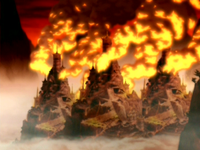
The Eastern Air Temple during the attack of the Fire Nation.
Fire Lord Sozin decided to launch his attack upon the arrival of Sozin's Comet. With the power of the Comet, Sozin's firebender armies launched a genocide on the pacifistic Air Nomads in an attempt to capture the new Avatar, Aang, and to break the Avatar Cycle.[29] This would overcome one of the Fire Nation's biggest obstacles to victory.[1] However, Aang had run away before the attack, thus escaping the carnage.[30] Almost all other Air Nomads were believed to have been killed in the attack, and the remainder ruthlessly hunted and killed as the Hundred Year War progressed, by the end leaving Aang the only known airbender left alive. Sozin would continue searching for Aang up until his death.[1] The Air Nomad Genocide involved massive firebending attacks on the four temples. Thousands of Air Nomads were slain along with their flying bison and lemurs.
Spread
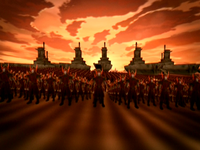
The first landing of the Fire Nation Army at the Earth Kingdom coast.
After the first strike against the Air Nomads, Fire Lord Sozin and his army began their first assaults into the western Earth Kingdom. Sozin's main objective was to overcome the next Avatar and secure a beachhead on the western coast of the continent and use it as staging grounds to advance further throughout the Earth Kingdom and to supply his forces. Other objectives were to cripple and destroy key Earth Kingdom trading centers to weaken the large Earth Kingdom economy. After several battles, including decisive Fire Nation victories in the Battle of Han Tui, the Battle of Garsai and the battle for Taku, the Fire Nation was able to gain a strong foothold in the Earth Kingdom.[31]
The Fire Nation's war effort was focused at the Western theater through the use of a large portion of the Fire Navy, but Sozin expanded northward and eventually was able to send forces to conduct an attempted invasion of the Northern Water Tribe fifteen years after the Hundred Year War began, which ended in failure due to the North Pole's treacherous landscape. The battle saw ground forces from both the Water Tribe and the Fire Nation confront each other directly.[12]
Middle stages (20 - 95 AG)
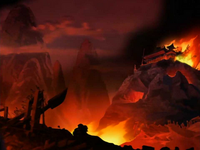
The results of the Hundred Year War in the Earth Kingdom.
Fire Lord Azulon took the throne after his father's death and began to advance south to the Southern Water Tribe and eastward toward the walls of Ba Sing Se. Forty years into the Hundred Year War, the Fire Navy attacked the Southern Water Tribe, at that time a prosperous settlement; their first attacks included the bombardment of several Water Tribe villages, but they later restricted their attacks to less costly surprise raids.[32]
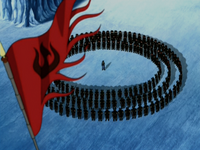
The last waterbender of the Southern Water Tribe, Hama, is captured.
Waterbenders across the South Pole fought the firebenders, and the Fire Nation adopted a policy of eradicating waterbending from the South Pole entirely, taking all waterbenders prisoner, leaving the nonbenders to fend for themselves. Among these prisoners was Hama, who notably developed a deep hatred for her captors but eventually escaped from captivity while waging her own personal war on them in secrecy. The Southern Water Tribe remained weak and the victim of constant raids, teetering on the edge of extinction. Eventually, the Fire Nation created the Southern Raiders, a brutal raiding force that pillaged and ravaged the coastlines of the South Sea, further weakening the Southern Water Tribe and devastating the at that time spared Southern Earth Kingdom.[7]
Soon, the Earth Kingdom came under many large-scale attacks, with the fall of the Hu Xin Provinces furthering the Fire Nation's advances into the Kingdom and putting them in control of the entire northwestern third of the continent. Thousands perished in massive violent battles during these campaigns.
During the war's ninety-fourth year, the Southern Water Tribe was attacked in yet another minor raid aimed at eliminating any remaining waterbenders. The attackers, the infamous Southern Raiders, were informed that one last waterbender, who happened to be Katara, was left in the Southern Water Tribe, and were given orders to kill her. However, Katara remained undiscovered because, during this raid, her mother Kya turned herself in as the last waterbender in an attempt to protect Katara. Kya was in turn killed, but her heroic act meant that the Fire Nation would never discover the true identity of the last waterbender in the South Pole.[32] Katara would later rediscover the Avatar and become a major contributor to the eventual capitulation of the Fire Nation as an indirect result of her mother's actions.[4]
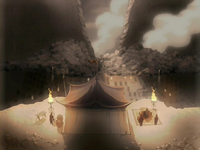
The Fire Nation camp inside the walls of Ba Sing Se.
In the Earth Kingdom theater, the Fire Nation enjoyed even more success, conquering every major Earth Kingdom city and stronghold until only Omashu (who hindered any major overland progress in the east) and Ba Sing Se were left. The Fire Nation Army also pushed down further south, conquering most of the southwestern coastlines. General Shu and his troops even advanced into the vicinity of the Si Wong Desert, fighting Earth Kingdom forces there. Finally, the Fire Nation Army reached the walls of Ba Sing Se itself, and the six hundred-day-Siege of Ba Sing Se began. In its final stages, the Fire Nation even managed to break through the Outer Wall, but their advance ended when their leader General Iroh's son was killed, resulting in Iroh's order to retreat. However, the order was also motivated by the fact his army was fatigued and had been embroiled in continuous fighting for so long.[33]
Late stages (95 - 100 AG)
Hope fades
In the last years of the war, the ferocity of the Hundred Year War eased slightly with the Fire Nation nearing victory. Ozai was crowned Fire Lord upon Azulon's death.[33] Iroh's forces retreated from the area of Ba Sing Se, although they remained in control of the Western Lake, where they began construction of a drill to help them penetrate Ba Sing Se's Outer Wall. The Northern Mountains were left alone, allowing refugees to move in.
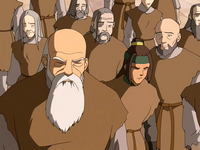
Earthbenders imprisoned by the Fire Nation lost hope, representing the declining morale of the Earth Kingdom citizens.
However, the conquered western shore of the Earth Kingdom was put under tighter control, where General Fong's fortress was the only Earth Kingdom military base left, hidden in a coastal mountain range.[34] Several fortified bases were set up there. Prince Zuko began his search for the Avatar upon his banishment three years before, hoping to reclaim his throne.[35] Zhao, an eager and ambitious naval officer, began plotting the conquest of the Northern Water Tribe.[36] Any attempt at rebellion was dealt with harshly, and the Fire Nation began arresting any earthbenders in their territory, forcing them into slave labor on offshore factories and shipyards.[37]
To add to the Earth Kingdom's troubles, a large number of their villages and cities were now under Fire Nation control, with their native citizens forced to obey the demands of the Fire Lord if they were to avoid persecution. Only non-essential territories were left alone. Even though major cities like Ba Sing Se and Omashu remained free at the time, the Fire Nation clearly controlled the majority of the continent, free to prowl almost anywhere in the north and west unopposed.[35]
Last Fire Nation offensives
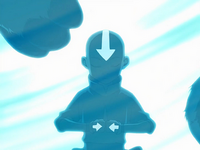
The fortunes of the Earth Kingdom and the Water Tribes made a turn for the better with the sudden return of the Avatar and last airbender, Aang, who was rediscovered by Sokka and Katara.[4] This immediately attracted the attention of both Zuko and Zhao, who chased him across the world. As the Avatar traveled north to the North Pole in an attempt to learn waterbending, Zhao was promoted to Admiral.[31] A small Fire Nation force attacked the Northern Mountains, only to be beaten back in what culminated as the battle for the Northern Air Temple. However, the defeated force did acquire an important new invention for the Fire Nation – the hot air balloon.[38]
Upon discovering that the Avatar had succeeded in reaching the North Pole, Zhao ordered his massive fleet to advance on the North Pole.[36] However, the Siege of the North was unsuccessful due to the Avatar's intervention, and the fleet was nearly entirely destroyed. Zhao was subsequently imprisoned in the Spirit World by La, the Ocean Spirit, after an unsuccessful attempt to kill the Moon Spirit in a bid to neutralize the waterbenders' power.[39] With the Fire Nation's main ambition in the north out of the picture and their control of the seas weakened, the Fire Nation refrained from further attacks on the Northern Water Tribe. However, as the Northern Water Tribe did not participate in any major engagements against the Fire Nation for the rest of the war, and the Earth Kingdom Navy was already all but obliterated, the loss of Zhao's fleet meant a bearable defeat. Ozai had his armies continue the slow and steady advances on all the Earth Kingdom fronts, while discreetly sending his daughter to search for the traitorous Iroh and Zuko.[40]
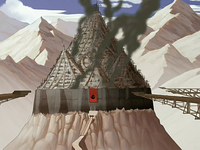
The conquered Omashu, renamed to "New Ozai".
Soon after the defeat at the North Pole, the Fire Nation won a great victory by conquering the city of Omashu, capturing King Bumi in the process, leaving Ba Sing Se the last major Earth Kingdom city in the north unconquered. Though most of the city's population managed to flee under the ruse of a plague, the city itself remained under the control of a Fire Nation governor and was renamed New Ozai by Princess Azula.[41]
The Fire Nation's next major battle would be at the walls of Ba Sing Se once more. The drill, a powerful and gigantic mechanized siege weapon, attacked the Outer Wall. However, the Avatar had just arrived. Though the machine succeeded in drilling through the Wall, it was destroyed by the Avatar, making the attack a failure and filling the newly drilled hole with wreckage.[42]
The Fall of the Earth Kingdom
- Main article: Coup of Ba Sing Se
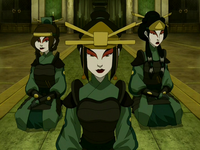
Princess Azula and her team infiltrate Ba Sing Se.
Princess Azula, Mai, and Ty Lee, a trio of the Fire Nation Academy's best, infiltrated the capital of Ba Sing Se.[9] Clad in Kyoshi Warriors uniforms, stolen from the warriors after having defeated them in an earlier engagement,[43] Azula infiltrated the court of the Earth King and undermined the Dai Li. She eventually convinced Long Feng to launch a coup d'état against the Earth King.[8] In the end, she double-crossed him and assumed control over the capital. She also succeeded in capturing her uncle and convincing Zuko to rejoin the Fire Nation, clouding his judgment by promising him his father's love. With Ba Sing Se under their control, the Fire Nation was even closer to victory, with only the tattered Water Tribes and parts of the Earth Kingdom left opposing them. Azula also learned that Ba Sing Se had been planning a major invasion of the Fire Nation home islands on the day of a solar eclipse in late summer, which would briefly leave all firebenders powerless.[8] With the Western Navy still recovering from the Siege of the North, the invasion might have been successful had the Dai Li not arrested the Council of Five.[13] Still, with knowledge that their homeland would still be vulnerable, the Fire Nation made plans to use this to their advantage.
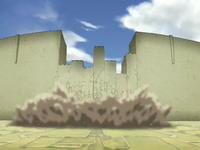
The walls of Ba Sing Se being brought down by Dai Li agents, marking the fall of the Earth Kingdom.
Additionally, Avatar Aang was gravely injured in a failed attempt to defeat Azula, who struck him down with a powerful lightning blast.[13] Although Katara was able to revive him, Aang remained in a coma in the following weeks, and he was immediately presumed dead by the entire world. When word of Aang's defeat spread across the globe, the Earth Kingdom and Water Tribes lost hope and the Fire Nation came close to declaring victory in its imperialist war.[44] Aang and his friends traveled into the Fire Nation incognito until the time to strike came again.[45]
Last counteroffensive, resistance, and escalation
Several weeks later, Ozai called a war meeting with his generals. One of them, Shinu, said that while Ba Sing Se had been conquered, a number of Earth Kingdom rebellions arose and that the Earth Kingdom military was still controlling vast swaths of territory, including the southern Earth Kingdom and scattered areas in the north, which kept the Fire Nation from claiming ultimate victory in the Hundred Year War. When Zuko said that the Earth Kingdom could endure anything as long as they had hope, Azula said they should "take their precious hope, and the rest of their land, and burn it all to the ground." Ozai, using this idea, planned to use the power of the returning Sozin's Comet to completely destroy the Earth Kingdom.[46]
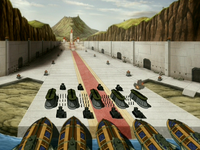
The invasion proved near-successful, though it was a big casualty for the water and earth forces.
Though the Fire Nation controlled great swathes of territory they were not unopposed. A small multinational invasion force led by Chief Hakoda of the Southern Water Tribe and the Avatar assaulted the Fire Nation Capital on the Day of Black Sun and they were nearly successful, but their supposed success was actually a carefully planned trap by the Fire Nation. Though they were repelled by the new Fire Nation air force of airships and most of the resistance leaders were captured, they proved that the Fire Nation could continue to be resisted as long as hope was maintained.[47]
However, the Day of Black Sun was not a total failure for those resisting the Fire Nation. During the Eclipse, the captured King Bumi saw the opportunity he had been waiting for. He broke out of his prison and, with the firebenders unable to firebend, retook the city of Omashu single-handedly.[48] Iroh also broke out of his cell and, according to a guard, fought as a "one-man army."
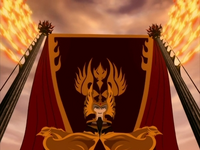
Ozai crowning himself Phoenix King, ruler of the world.
Prince Zuko realized the full extent of the Fire Nation's crimes and joined the Avatar, agreeing to teach Aang firebending before the anticipated battle with the Fire Lord.[49] This development only increased the threat the Avatar posed toward the Fire Nation. Coinciding with this, Princess Azula was betrayed by her allies, Mai and Ty Lee, after a failed sabotaging of an escape from the Boiling Rock, badly hurting both her psyche and her leadership ability.[50]
Fire Lord Ozai crowned himself Phoenix King prior to the arrival of Sozin's Comet and appointed Azula to be his successor as Fire Lord. Ozai intended to finish the Hundred Year War by using the comet's immense power to vanquish his enemies, so the Avatar's group, one of the Fire Nation's greatest threats, acted quickly to prevent this catastrophe.[46]
Conclusion (100 AG)
Fall of leaders
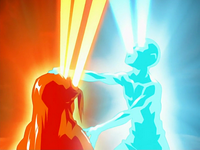
Aang strips away Ozai's firebending through energybending, signaling the Fire Lord's defeat.
When Sozin's Comet made its return to the world, Ozai launched his massive attack on the Earth Kingdom with his armada of airships. When he arrived at the Wulong Forest, which he quickly proceeded to incinerate, Avatar Aang confronted him. Despite Aang's pleas to end the Hundred Year War peacefully, Ozai attacked him. At first, Ozai and Aang were evenly matched, but Aang refused to go on the offensive due to his belief that all life was sacred.[15] Ozai gained the upper hand, but accidentally smashed Aang into a rock that hit the scar on his back where Azula had struck him with lightning at Ba Sing Se. This released the pent up energy there and opened his seventh chakra, allowing Aang to enter the Avatar State. Using the Avatar State's power, Aang went on the offensive. Despite his enhanced firebending, Ozai was quickly overwhelmed and forced to retreat. Aang pursued him and eventually pinned him down. But just as he was about to deliver the finishing blow, Aang left the Avatar State. Instead of killing Ozai, Aang used energybending to strip him of his firebending.[5]
Endgame
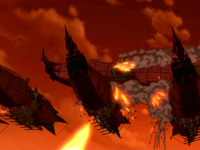
The airships are destroyed.
While Aang and Ozai fought, three members of the Avatar's group, Sokka, Toph and Suki, hijacked one of the airships in Ozai's armada. Rammed the airship into the ones next to them, they successfully destroyed the fleet. The Order of the White Lotus, under Iroh's leadership, successfully retook Ba Sing Se, a colossal defeat for the Fire Nation.
Azula, after losing the alliance of Mai and Ty Lee,[50] was weakened by a state of mental instability. This caused her to lose all trust in everyone, developing severe paranoia and coming to the belief that everyone was against her. She banished all those loyal to her, and in effect, had no allies or external protection. This rendered her unable to effectively fight Zuko and Katara, resulting in Zuko's victory in their Agni-Kai and taking her place as Fire Lord. She suffered a mental breakdown immediately after the conclusion of their fight, making her incapable of continuing to fight in the Hundred Year War.[5][15]
With the loss of Omashu, Ba Sing Se, and the fall of their leaders, the Fire Nation Armies found themselves unable to continue the war effort, leaving the Water Tribe and the Earth Kingdom victorious.[5]
Aftermath
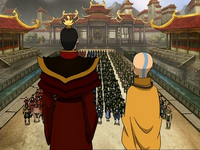
After these victories, all the prisoners of war were released and Zuko was crowned Fire Lord, officially declaring the war to be over. At his coronation, he promised before a large audience of the world's citizens that he would dedicate his rule to rebuilding the war-torn world with the help of Avatar Aang.
After being defeated by Aang, Fire Lord Ozai was arrested and put in prison, and Azula had been institutionalized in a mental health facility on an isolated island near the Fire Nation capital.[16]
However, after a century of fighting, all four nations were left exhausted from the conflict. Over the course of the war, the Fire Nation had caused unprecedented worldwide devastation and loss of life, annihilating an entire nation save for one person, and oppressing people on a large scale. While the overall infrastructure of the Earth Kingdom and Southern Water Tribe suffered gravely, the Northern Water Tribe came out relatively unscathed, albeit more isolated than before, and the Fire Nation mostly suffered a cultural loss: dancing was kept downtrodden, resulting in the loss of several ancient dance moves, sections of their history prior to the war were sealed off and eventually forgotten, and firebending became distorted into being fueled by hatred and rage rather than as a veneration of life and energy, a process that was only sped up when the dragons, the original firebenders, were pushed to the brink of extinction due to Sozin starting the tradition of hunting them for glory. The nation's focus also turned more to warfare, which placed its spirituality in the background, causing the Fire Sages to fall from prominence.
With the war's conclusion, however, all nations could begin the long process of rebuilding, both physically as spiritually.[5] The Harmony Restoration Movement was created as a step toward peace in removing the Fire Nation colonies from the Earth Kingdom. However, after seeing all the hard work his people had done in the colonies, Fire Lord Zuko removed his support from the movement. This decision started a confrontation that threatened to throw the world back into war, causing Avatar Aang to intervene. After a brief skirmish, an agreement was reached, which eventually led to the Fire Nation colonies being transformed into the United Republic of Nations.[3][51][6]
War capabilities
During the war, it was obvious from the beginning that there was a great disparity in means and effectiveness between the military powers of the four nations. For the most part, the nations that opposed the Fire Nation lacked a united front that would allow them to launch a successful counterattack.
Air Nomads
The Air Nomads, being pacifistic, had no formal military power, nor any standing means of fighting a war. Being nomadic and reclusive from the world-at-large, they believed that they were for the most part safe from military excursions. They possessed no weapons, and whatever they created was hand-made. Despite this, they did mount a defense when the temples came under attack and though they were ultimately wiped out, the Fire Nation suffered several casualties.[52]
Water Tribes
Northern Tribe
The Northern Water Tribe was an isolated power that managed to survive mostly unscathed for much of the war because of its remote and treacherous location. Centralized around tribal leaders and unified by a cultural feeling of unity, the Northern tribe was able to unite in the face of Fire Nation aggression.
The Northern Tribe had a warrior class, as opposed to a standing army. The tribe had a large number of benders able to utilize the surroundings of their home, and a number of nonbending warriors who utilized spears and various weapons made from animal bones. For the majority of the war, women were forbidden from offensive waterbending, restricted to healing, and social convention kept them from being warriors.
While they did not have a navy, waterbenders used small canoes to surround and neutralize the bulky Fire Nation warships. This worked well against individual ships, or small groups, but was impractical against fleets, and especially the armada assembled by Zhao. These ships were not made for journeys, but for quick response to immediate threats.
Southern Tribe
Unlike the Northern Tribe, the Southern Water Tribe employed female waterbenders. The Southern Tribe was much more isolated than their sister tribe, and close to the end of the Hundred Year War suffered near extinction. All waterbenders, apart from Katara, were removed from the Southern Tribe during the middle of the war, essentially eliminating the Southern Tribe as a factor in the overall war.
As opposed to the almost impregnable fortress-like city of the Northern Tribe, the Southern Tribe had a much smaller, inland walled-town. Over time this town was reduced to a makeshift village.
By this time, the warriors of the tribe departed for the Earth Kingdom, led by Chief Hakoda. The only people left in the tribe were Katara, Sokka, mothers and their children, and the elderly, leaving the village effectively defenseless.
The Southern Tribe employed sailing ships made of bones and animal skins. After the Siege of the North, the Northern Water Tribe sent a group of waterbenders and others to the South Pole in order to help rebuild their shattered sister tribe.
Foggy Swamp Tribe
The Foggy Swamp Tribe were a relatively primitive tribe that possessed no major or advanced technology. This, coupled with the isolation of their habitat, the Foggy Swamp, meant that they passed beneath the radar of the other nations until they encountered Team Avatar around 99-100 AG.[53] As such, the Foggy Swamp Tribe was not involved in the war until months prior to its conclusion, when they participated in the invasion of the Fire Nation,[14] which resulted in the imprisonment of several of its members.[47]
Earth Kingdom
The Earth Kingdom was composed of a number of provinces loosely controlled by the Earth King in Ba Sing Se. Though they had the largest population and territory of all the nations, the Earth Kingdom lacked a well-organized, powerful central government like the Fire Nation. Most of its provinces had their own local lords or, in cases like Omashu, kings who were largely autonomous.
This political divisiveness meant that the majority of Earth Kingdom military retaliation to the Fire Nation was conducted by these provincial lords and kings. By the time of the reign of Earth King Kuei, the Earth King was a puppet ruler who had no knowledge of the war and no control over the military until the Grand Secretariat, Long Feng, was arrested. The Earth King's sphere of influence was limited to the walls of Ba Sing Se itself.
Earth Kingdom military prowess paled in comparison to the tactics of the Fire Nation Army. The army as a whole was structured similarly: benders and a number of varying sorts of nonbender infantry, such as pikemen and swordsmen. Whereas the Fire Nation used mainly machines, along with rhinos for certain terrain, the Earth Kingdom typically employed animal labor, such as ostrich horse cavalry, which had a diverse amount of uses. The only non-animal vehicle known were stone tanks mounted on caterpillar treads. Moved via earthbending, these tanks were versatile juggernauts capable of laying waste to their metal Fire Nation counterparts, though they only became available to the Earth Kingdom Army during the final stage of the war.
The Earth Kingdom navy utilized wooden ships. The Fire Navy dominated the seas during the Great War, with the Earth Kingdom possessing no seen naval presence, although General How mentioned there still being naval forces during the Council of Five's discussion of the invasion plan.
The Earth Kingdom possessed no air force. The technology was newly founded by the time of the coup.
Near the end of the Hundred Year War, the multi-ethnic invasion force that invaded the Fire Nation on the solar eclipse possessed several new technological devices, including caterpillar-tread transports, submarines, and a number of smaller inventions devised by Sokka and the mechanist. Most of these were not employed by the Earth Kingdom as a whole at this time, as at this point Ba Sing Se had fallen to the Fire Nation.
Fire Nation
The Fire Nation, a relatively small but prosperous empire, possessed technological prowess beyond any of the other nations. By the time the war began, they had metal-based ships, steam-powered engines and machines, the ability to mass-produce standard military hardware, and many other industrial-age based social, economic, and political traits. Numerous factories for metalwork, military construction, and commodities dotted the Fire Nation homeland.
Unlike the Earth Kingdom, the Fire Nation was a centralized power from the beginning of the war, directly controlled and directed by the dictatorial power of the Fire Lord and his advisers. This combination of unity and technological advancement gave the Fire Nation a distinct edge over its main military opponent, the Earth Kingdom, which still functioned under a feudal system. The Fire Nation military was organized, rigidly controlled, and directed by the Fire Lord and his council of generals. The army was organized into benders, various divisions of nonbenders, such as archers, pikemen and swordsmen, and into a domestic national guard. The army employed a variety of war machines, including steam-powered tanks, trebuchet artillery, and the drill.
The navy was structured similarly, possessing several fleets of the most advanced warships in the world, including a domestic defense fleet that formed a large blockade around Fire Nation waters. These ships were steam-powered and used deck-mounted trebuchets for long-range assault.
Near to the end of the war, the Fire Nation also employed a burgeoning air force of airships and zeppelins, utilizing benders for close-quarters defense and bombs for air-to-ground bombardment. The zeppelins also featured a forward-cannon for shooting bombs forward at level targets.
The Fire Nation initially had surprise on their side; however, given the intervention of Avatar Roku, this was lost to the twenty years between the first established colony, and the death of Roku, which allowed Sozin to pursue his ambition.
List of known major engagements
Trivia
- The war's monikers, the Hundred Year War and the Great War, can be perceived as allusions to the real-world Hundred Years' War and World War I, the latter of which was alternatively known as the Great War and was notable for being the first war involving all the major world powers.
- The Hundred Year War further resembles World War I in the fact that it was the first war to introduce cutting-edge technology into warfare, such as blimps, submarines, and tanks, while at the same time still employing older-styled clothing, cuirasses, and melee weapons.
- The Hundred Year War also resembles the Second Sino-Japanese War, or the Asian front of World War II, in that a technologically advanced island nation invaded a massive continental power with great success. Both instigators also rationalized their imperialistic endeavors as a means of sharing prosperity; for Japan, expansion into other Asian countries was deemed necessary in order to establish the Greater East Asia Co-Prosperity Sphere.
References
no:Hundreårskrigen